Migrant Farm Workers in the United States: Photo Essay
A Dormitory for Migrant Workers, as I Remember It
Original Drawing
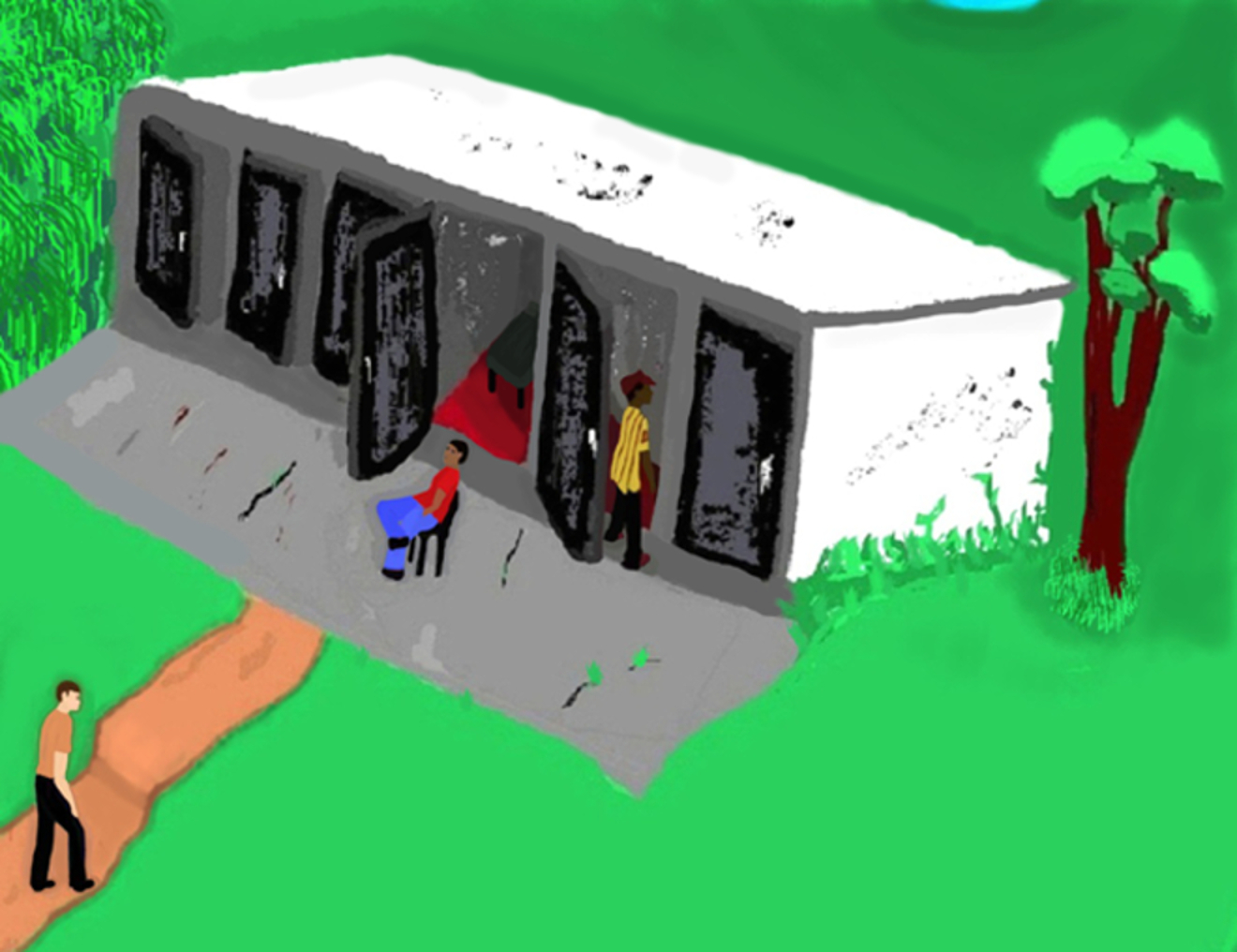
I spent my earliest years in a New York (USA) farm community. The rhythm of daily activity was determined by the seasonal ebb and flow of life. For schools, this meant class size swelled with the coming of spring, when children of migrant workers registered in local districts. These students sat at desks with the rest of us, but weren't really part of the class. We all knew they were temporary, and that their academic skills would generally reflect their transient status.
One summer day, when I was walking with an adult relative, I passed what looked like a dry gully. At the bottom of the steep slope was a concrete, slab structure. Men walked about, in front of the building. My adult companion explained that this was a residence for migrant workers. The starkness of their dormitory made an indelible impression on me.
Not long after this sighting, my grandfather, who owned a large farm, recruited me to pick strawberries. There must have been a harvest crisis, because he never asked me before or after that day to work on the farm.
Many laborers were in the field with me. In the space of a few hours, I got a sense of what it was like to pick fruit, with the sun shining on a shadeless expanse, and no water in sight, except for the contents of a warm mason jar far off on the back of a flatbed truck.
Migrant Farm Workers, A Photo Essay.
All photos included in this essay are from Wikimedia Commons. Some pictures are not linked to a source because their captions contained racist language. This, in itself, was sobering for me.
The picture above, entitled "Pea Pickers", was taken by the legendary Dorothea Lange, in Nipono, CA, on behalf of the US Farm Security Administration (1936). Lange traveled across the country during the Great Depression and documented the experience of families that had been uprooted. Her pictures became a visual history. They captured an era, particularly the struggle of those displaced by the environmental catastrophe of the Dust Bowl. Public domain.
Dorothea Lange took the photo above for the US Department of Agriculture. The caption under the picture indicates it was a segregated housing section for cotton pickers. There was a separate housing section for whites that looked exactly the same. The picture was taken in 1940, at Cortar Farms in Pinal County, AZ. From the National Archives Administration. Public domain.
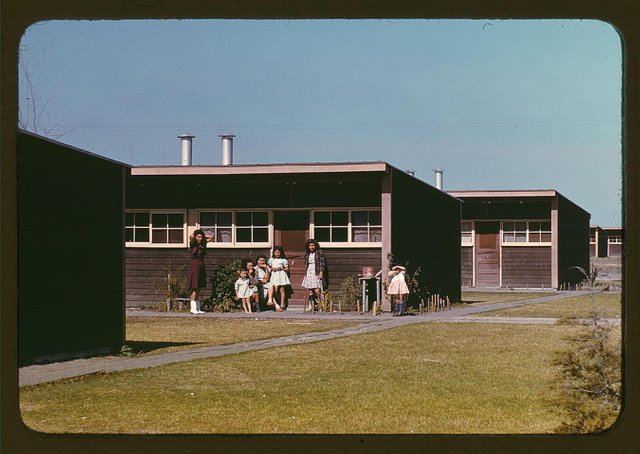
The picture above, taken by Arthur Rothstein, shows children of migrant workers in front of their row houses. The picture was taken in 1942 for the US Farm Security Administration at a labor camp in Robstown, TX. Public domain.
These dwellings (photo above) for farmworkers, in Belle Glade, FL, were condemned as uninhabitable. The picture was taken by Marion Post Wolcott, in 1940, for the US Farm Security Administration. Public domain.
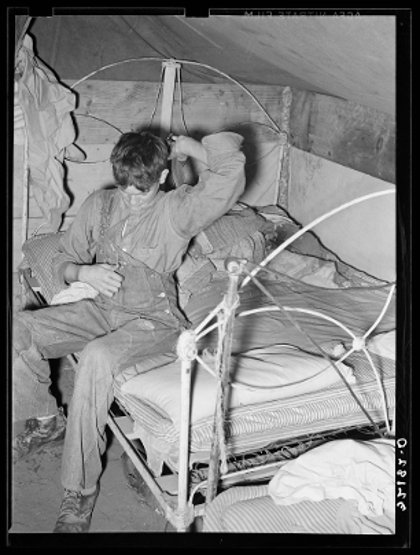
The picture above was taken by Russell Lee at a camp for migratory workers in Harlingen, TX (1939). According to the caption, the child is putting on overalls and is living in a tent. The picture was shot on behalf of the US Office of War Information and is in the public domain.
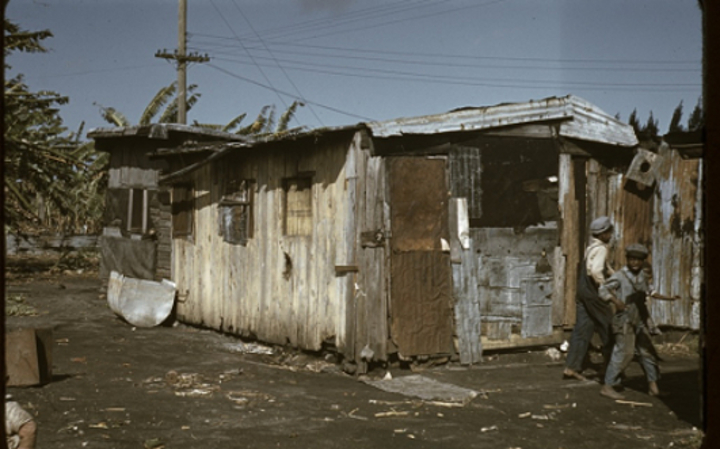
It's hard to tell if the people in the foreground (of the picture above) are boys or men. They are standing outside housing for migrant workers in Belle Glade, FL, 1939. The photo was taken by Marion Post Wolcott on behalf of the US Farm Security Administration, 1939. Public domain.
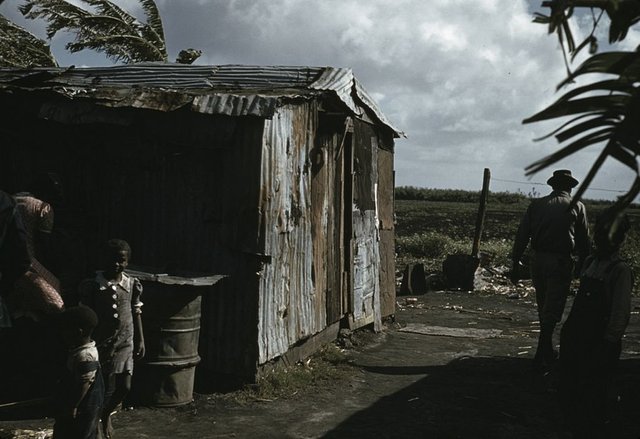
Another picture by Marion Post Wolcott at the Belle Glade, FL, camp for migratory farmworkers. This family was photographed in 1944. The photo was released by the US Office of War Information. Public domain.
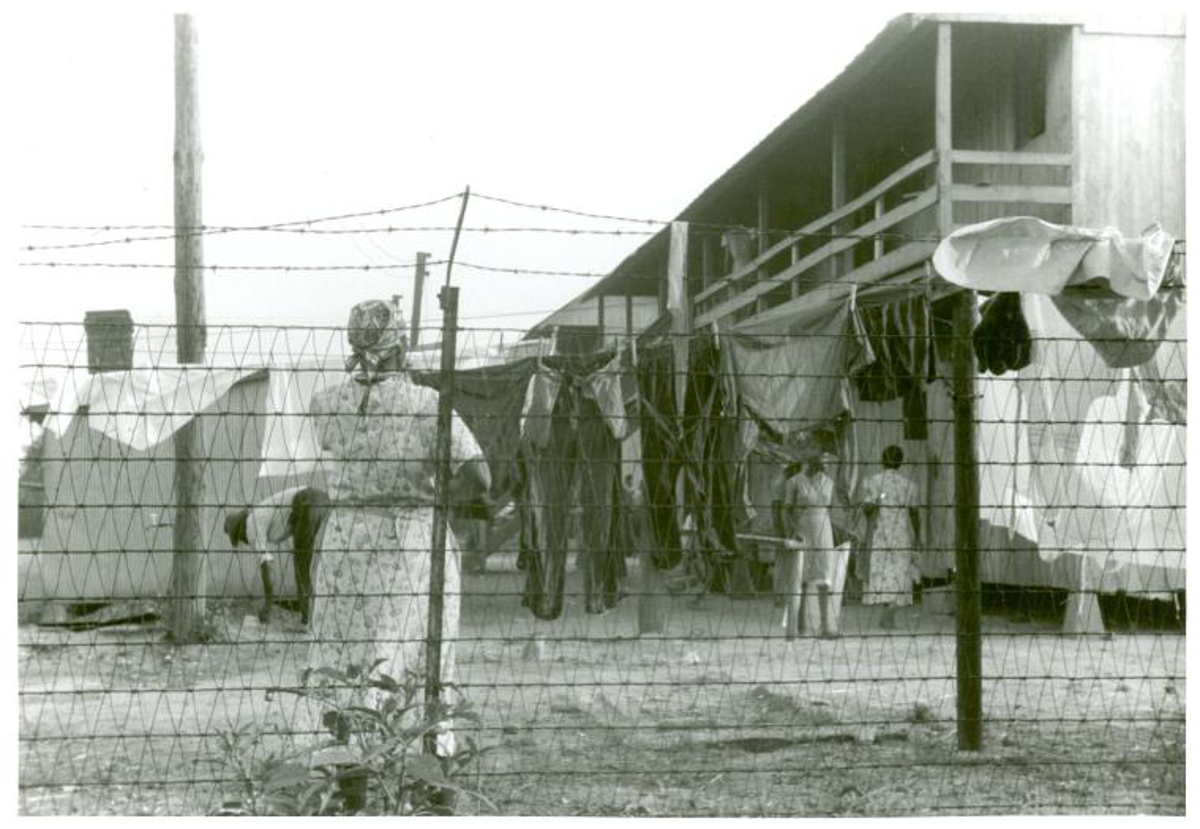
This photo, of a barbed-wire-enclosed camp for migratory workers, was taken by Jack Delano at the Cannon Company in Bridgeville, DE. The photo was released by the US Farm Security Administration in 1944. Public domain.
This photo, by Dorothea Lange, was taken in San Joaquin Valley, CA, in 1953. The labor camp was established for pea pickers. The field on which they worked can be seen in the distance. The large tent in the picture was the temporary school set up for the children. According to the caption associated with this photo, the shot was taken as Ms. Lange looked down from a water tower. Photo was released by the US Farm Security Administration. Public domain.
Housing Migrant Workers Today: Meeting Challenges
According to the American Public Health Association there is no way to ascertain how many people work with migrant and/or seasonal status. The Association estimates the number to be between 1.6 and 5 million. One issue facing these workers is housing. A PEW Charitable Trust Report describes numerous state and federal regulations that mandate minimum housing standards. These regulations, however, are not strictly enforced. The report indicates, for example, that between 2005 and 2016, not one citation for housing violation (for migrant/seasonal workers) was issued in the state of Texas. The problem of sub-standard housing is compounded by fear. If a complaint is not lodged, an investigation cannot go forward. Workers are afraid to complain because they may not only lose their income, but also their shelter.
Climate Change and Housing for Migrant Workers
It is predicted that with climate change will come increased challenges to migrant/seasonal workers in the future. Climate-related pressures on agriculture are projected to have a negative impact on livestock and crops. This will not only affect employment opportunities and patterns for migrant workers, but will also add cost pressures on producers, who will look to cut overhead, including expenses for housing and services.
The trend in housing for migrant/seasonal workers is to have workers rent off-site accommodations, at free-market rates. Given the limited resources of workers, this free--market housing will most likely lack many of the essential qualities recommended by WHO: protect workers from communicable diseases and injury; minimize psychological stress; protect those who are identified as at risk; and allow access to healthcare, work and essential services.
Other Effects of Climate Change on Migrant Workers
In addition to housing issues, the Worldwatch Institute cites a number of studies that suggest rising temperatures will lead to an increase in heat related illness, HRI, for agricultural workers. One NCBI Journal report describes a rise in HRI already evident in Oregon. The report indicates that outdoor workers have a particular vulnerability to climate change. Those workers who are paid by the piece, rather than by the hour, run an even greater risk because of their reluctance to take breaks, cool off, and hydrate.
Another anticipated challenge that will confront agricultural workers, because of climate change, is an elevated risk of contracting a vector-borne disease (caused by insects or parasites). This increase will be a consequence of prolonged growing seasons, and also of exposure to pathogens that are newly introduced into regions. Workers who handle livestock, particularly those who are involved in the slaughter of animals, will run a special risk.
Please note: the picture at the top of the page was derived from a drawing I did for a self-published book. I found that book to be unsatisfactory, so it is now off the market. The modified picture (shown on this blog) will appear (I hope) in my upcoming book, Arrows Axes and Scythes. There are certainly to be more modifications.
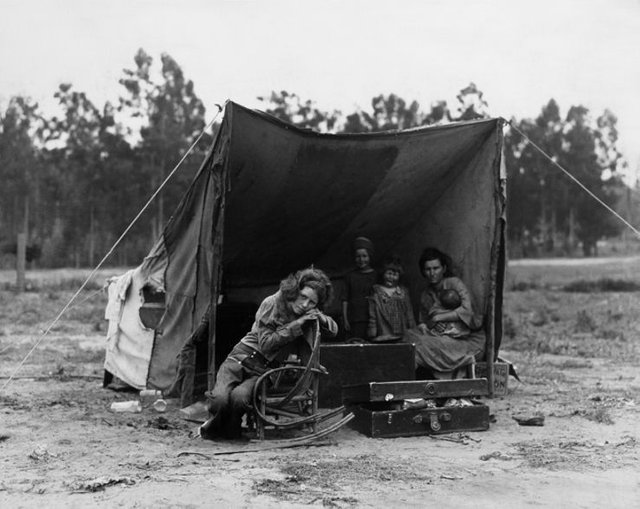
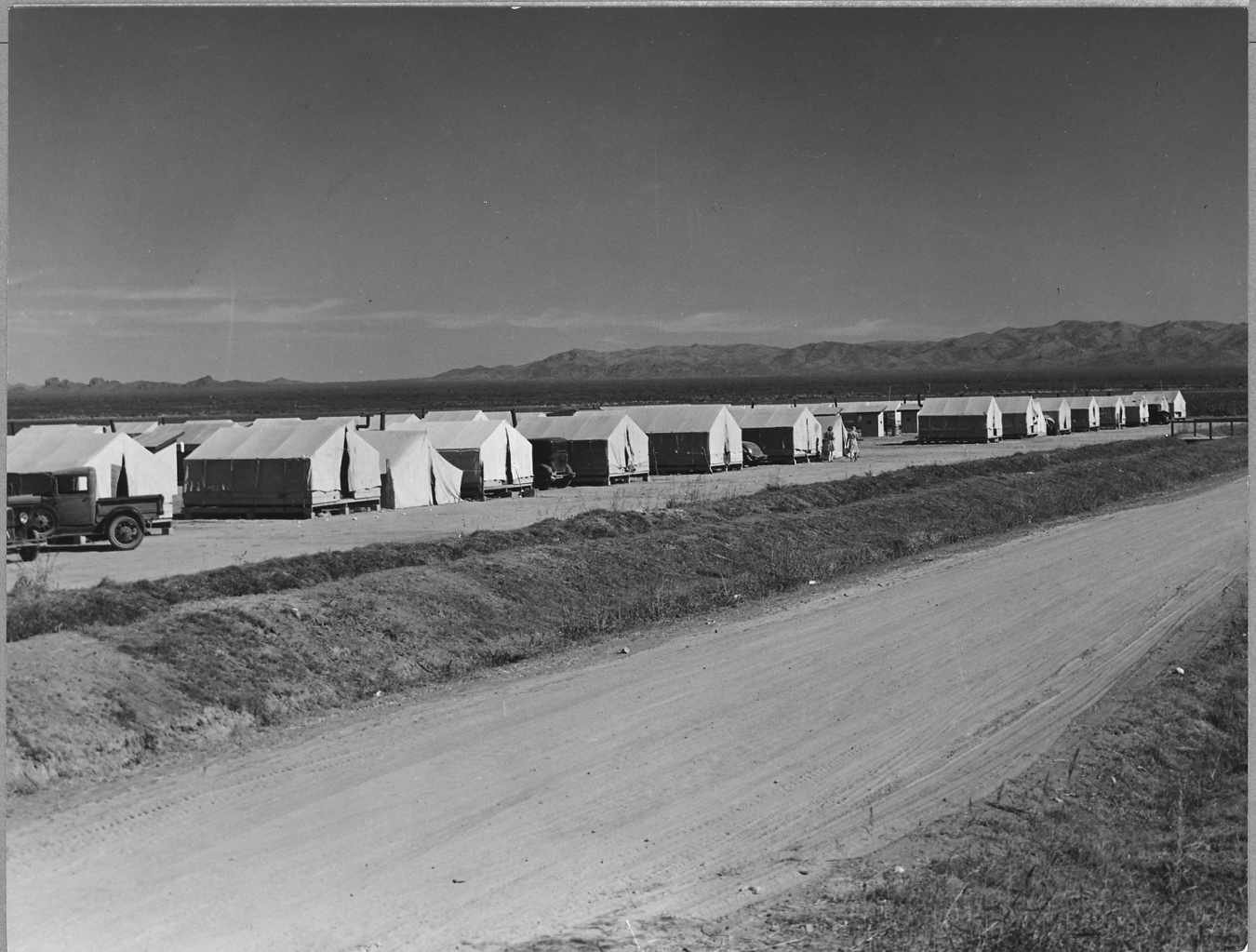
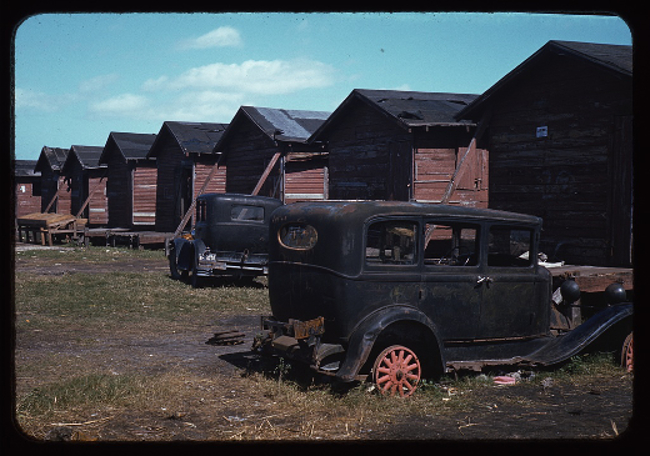
%2C%20Dorothea%20Lange%2C%20view%20from%20water%20tower%201953.jpg)
Thanks for the in depth and engaging article. I enjoyed reading it and learning new things about the plight of migrant workers. Thanks again!
I have featured your post in my entry for a curation competition..
I think if you also put in an entry there a bonus prizes for newcomers that are featured.
came from @bengy entry post.
Found you from the Pay It Forward Contest.
Thank you, @bengy! The generosity of steemians always amazes me. Haven't even had my morning coffee yet--woke to find your kind comment. Nice wake-up. I will follow your recommendation and try to put in an entry.
Thank you so much again.
@bengy featured you in The Pay It Forward contest . That is how I came upon your post .
I worked for a guy who grew up in a migrant family . He would tell stories about how they would go from state to state following the crop . Heart felt stories
Thank you, @wolfhart! I was trying to give visibility to people who are usually invisible to most of us. Pictures of the children, especially, were moving. Would be interesting to hear some of the stories the man (who grew up in a migrant family) told you.
I saw your entry from @bengy's Pay it Forward contest entry. (I'm one of the judges)
I grew up on a farm and remember the migrant workers as well; it's interesting how as a kid, you sense something not quite right with it all, but all our kid mind knows is to feel badly, and rightly so.
Such an interesting and well-written post. Thank you for that.
I see you are fairly new to steemit and wondered if you'd had a chance to join any Discord groups? I curate for @asapers; we aren't huge but we focus on quality unnoticed posts...one's like this.
I'm leaving you the link to join https://discord.gg/Hrqyug anyway, and I'm going to submit your post in the hopes that you do :) We release a newsletter regularly called READ me ASAP where we showcase authors and I'm hoping we can get yours in there to give you a bit more exposure.
Any questions, please feel free to ask :)
I am gratified you find my pieces worthy. When I write, I always see where I'm going. It's clear in my head and the trip is stimulating. After I post, self-doubt sets in. Fortunately, I love writing and researching so my mind is soon on another idea and I go forward.
As I mention in your 'robot' comment, I will certainly give @asapers a try. Discord is confusing to me (discord, indeed!). I'm not very good at chatting, but I am good at sharing. I'll click on that link and see what happens. Maybe a small group will be less confusing to me.
Thanks so much for the invitation.
Truthfully, I don't chat much in there, but it is a great spot to share ideas, your posts etc., and the small group is more conducive to developing genuine relationships I think.
As far as your writing goes, I think it's very good...sounds mediocre, but I don't mean it that way; I'm tired and can't come up with too many adjectives right now haha "Self-doubts" are common; you wouldn't be a writer without them, or at the very least, you and I stand on common ground with that one!
I see you joined @asapers; welcome :) If you ever need anything, please let me know. If you can't figure out how to in Discord, pop me a line on one of my posts and I'll help you figure it out ;) I think you'll find everyone is pretty helpful there.
Thanks for the gracious welcome. Little tired myself tonight. Start fresh in the morning.
I don't blame you at all! Sometimes you just have to shut it down!
There are quite a few migrant workers in the summer in my area. They come for cherry season. You regularly see them out and about around town, but I have or idea where they live for the summer. Housing is really expensive here. My city was recently ranked in the top 3 percent for most unaffordable cities in the US. It is possible they live outside of the city closer to the farms and just come to town to shop. I am really not sure though.
So many people fail to realize the broad effect that climate change has on the world. It literally affects everything.
My grandfather (paternal) had quite a large farm. We left that community when I was eleven and never went back so I don't know much about it, but I do remember that a large contingent of migrant workers came by every summer. And I remember the kids in school. Even as a very young child I felt bad for them. It seemed they were just holding places until they moved on. A small community can be very hierarchical--your social status is inescapable. Add to that race, and they pretty much didn't have a chance around there. I wonder how much opportunity they had anywhere. Anyway, that memory always stayed with me.
This is so incredibly interesting. I spent a good part of the last two years working with my old research collective on circular migration in India. We mapped the patterns of movement of seasonal labourers between the city and the village and how their dwellings in both places reflected the lifestyle in another.
One of our arguments was always that in any census count, migration is measured in absolute terms - in migration and out migration. There is no methodology or means to account for those who come in and go out depending on the season. If we had to take a step back from the seasonal migration patterns of just agricultural workers and look at the changing work patterns of the world, we see that a growing number of the population travels between places for various reasons: work, marriage, family, etc.
We need to have a framework to account for this ebb and flow in a city if we want to truly benefit of this manpower that is actually responsible for running the city.
I'd love to read more about your experiences of living in a farm community! As always, great post and I look forward to reading more on the subject.
Thank you. As you can tell from my post, this is an issue that deeply affects me. While I wrote, I was very conscious of migration as a global phenomenon, particularly in those areas most severely affected climate change.
I thought, showing pictures would reach people in a way that words cannot. Migrant workers are among the many, many invisible, who, as you say, are actually responsible for keeping the machinery of society oiled. I'm not surprised that these under-counted and unseen are visible to you.
Your work with the research collective sounds fascinating. You might want to write about that sometime.
https://mb2-717-dumps.blogspot.com/2020/09/get-valid-huawei-h13-629v20-dumps.html
https://cs0-001-dumps.blogspot.com/2020/09/the-way-to-pass-exam-with-h35-211-exam.html
https://pass4sure-200-150-dcicn.blogspot.com/2020/09/knowledge-most-current-huawei-h31.html
https://www.olaladirectory.com.au/updated-nutanix-ncp-5-10-exam-preparation-material/
https://medium.com/@azytrend/ace-pdf-questions-perfect-idea-for-ace-test-preparation-2aea76b336e9
https://www.olaladirectory.com.au/brilliant-ncse-core-exam-questions-with-pdf-dumps/
https://www.lily.fi/blogit/exambraindumps/latest-ibm-c1000-056-braindumps-for-huge-success/
http://certificationexam.educatorpages.com/